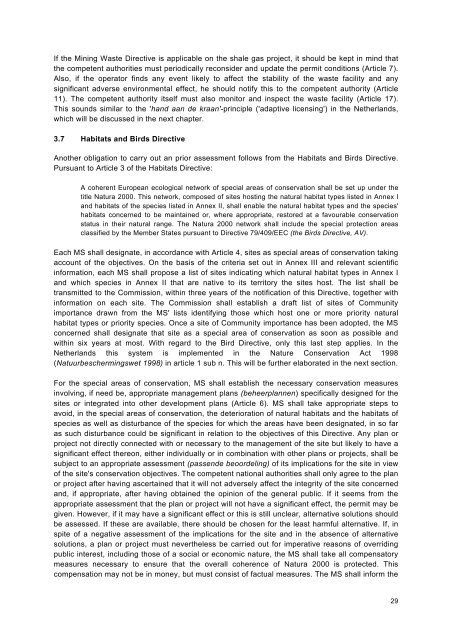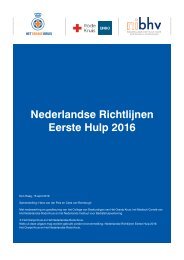Thesis-Anne-Vos-Masters-SBR-and-EU-Law-3
Thesis-Anne-Vos-Masters-SBR-and-EU-Law-3
Thesis-Anne-Vos-Masters-SBR-and-EU-Law-3
Create successful ePaper yourself
Turn your PDF publications into a flip-book with our unique Google optimized e-Paper software.
If the Mining Waste Directive is applicable on the shale gas project, it should be kept in mind that<br />
the competent authorities must periodically reconsider <strong>and</strong> update the permit conditions (Article 7).<br />
Also, if the operator finds any event likely to affect the stability of the waste facility <strong>and</strong> any<br />
significant adverse environmental effect, he should notify this to the competent authority (Article<br />
11). The competent authority itself must also monitor <strong>and</strong> inspect the waste facility (Article 17).<br />
This sounds similar to the 'h<strong>and</strong> aan de kraan'-principle ('adaptive licensing') in the Netherl<strong>and</strong>s,<br />
which will be discussed in the next chapter.<br />
3.7 Habitats <strong>and</strong> Birds Directive<br />
Another obligation to carry out an prior assessment follows from the Habitats <strong>and</strong> Birds Directive.<br />
Pursuant to Article 3 of the Habitats Directive:<br />
A coherent European ecological network of special areas of conservation shall be set up under the<br />
title Natura 2000. This network, composed of sites hosting the natural habitat types listed in <strong>Anne</strong>x I<br />
<strong>and</strong> habitats of the species listed in <strong>Anne</strong>x II, shall enable the natural habitat types <strong>and</strong> the species'<br />
habitats concerned to be maintained or, where appropriate, restored at a favourable conservation<br />
status in their natural range. The Natura 2000 network shall include the special protection areas<br />
classified by the Member States pursuant to Directive 79/409/EEC (the Birds Directive, AV).<br />
Each MS shall designate, in accordance with Article 4, sites as special areas of conservation taking<br />
account of the objectives. On the basis of the criteria set out in <strong>Anne</strong>x III <strong>and</strong> relevant scientific<br />
information, each MS shall propose a list of sites indicating which natural habitat types in <strong>Anne</strong>x I<br />
<strong>and</strong> which species in <strong>Anne</strong>x II that are native to its territory the sites host. The list shall be<br />
transmitted to the Commission, within three years of the notification of this Directive, together with<br />
information on each site. The Commission shall establish a draft list of sites of Community<br />
importance drawn from the MS' lists identifying those which host one or more priority natural<br />
habitat types or priority species. Once a site of Community importance has been adopted, the MS<br />
concerned shall designate that site as a special area of conservation as soon as possible <strong>and</strong><br />
within six years at most. With regard to the Bird Directive, only this last step applies. In the<br />
Netherl<strong>and</strong>s this system is implemented in the Nature Conservation Act 1998<br />
(Natuurbeschermingswet 1998) in article 1 sub n. This will be further elaborated in the next section.<br />
For the special areas of conservation, MS shall establish the necessary conservation measures<br />
involving, if need be, appropriate management plans (beheerplannen) specifically designed for the<br />
sites or integrated into other development plans (Article 6). MS shall take appropriate steps to<br />
avoid, in the special areas of conservation, the deterioration of natural habitats <strong>and</strong> the habitats of<br />
species as well as disturbance of the species for which the areas have been designated, in so far<br />
as such disturbance could be significant in relation to the objectives of this Directive. Any plan or<br />
project not directly connected with or necessary to the management of the site but likely to have a<br />
significant effect thereon, either individually or in combination with other plans or projects, shall be<br />
subject to an appropriate assessment (passende beoordeling) of its implications for the site in view<br />
of the site's conservation objectives. The competent national authorities shall only agree to the plan<br />
or project after having ascertained that it will not adversely affect the integrity of the site concerned<br />
<strong>and</strong>, if appropriate, after having obtained the opinion of the general public. If it seems from the<br />
appropriate assessment that the plan or project will not have a significant effect, the permit may be<br />
given. However, if it may have a significant effect or this is still unclear, alternative solutions should<br />
be assessed. If these are available, there should be chosen for the least harmful alternative. If, in<br />
spite of a negative assessment of the implications for the site <strong>and</strong> in the absence of alternative<br />
solutions, a plan or project must nevertheless be carried out for imperative reasons of overriding<br />
public interest, including those of a social or economic nature, the MS shall take all compensatory<br />
measures necessary to ensure that the overall coherence of Natura 2000 is protected. This<br />
compensation may not be in money, but must consist of factual measures. The MS shall inform the<br />
29



